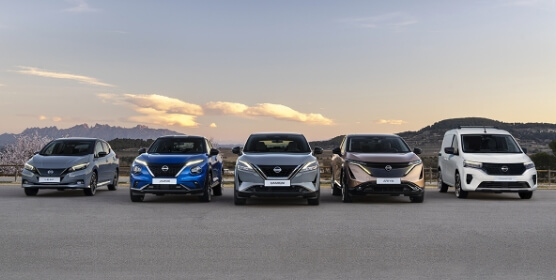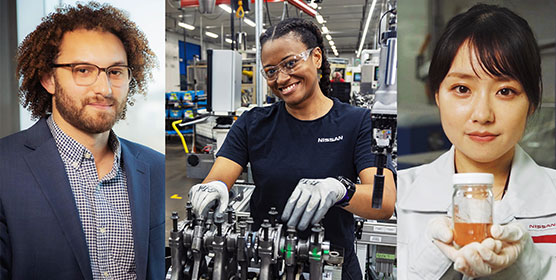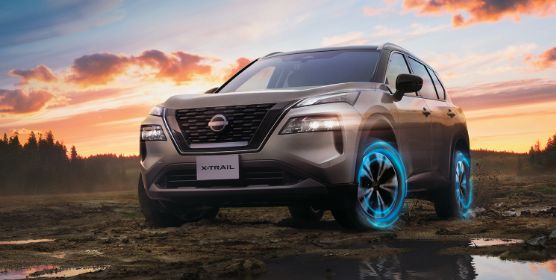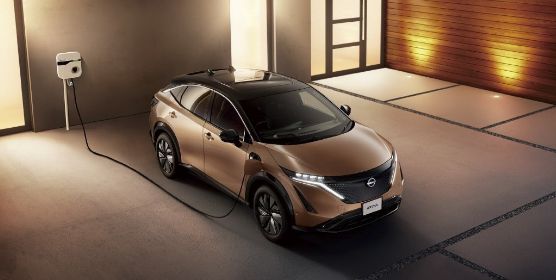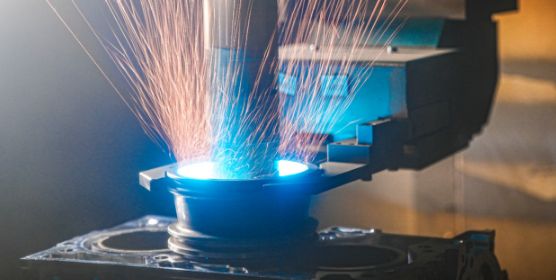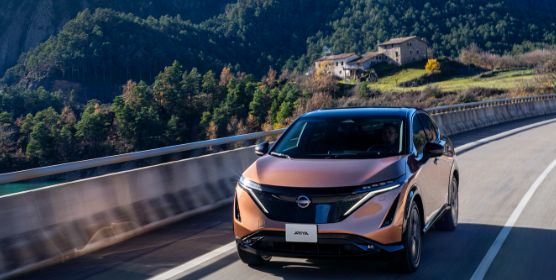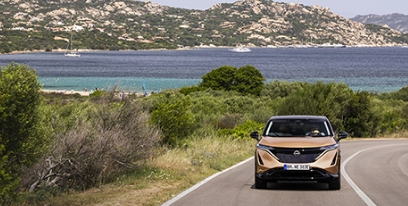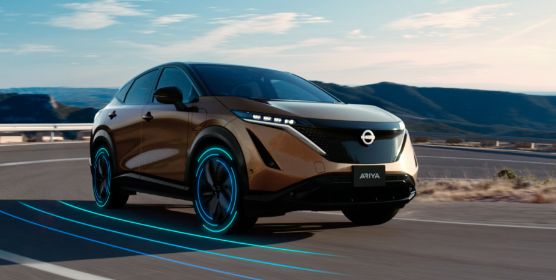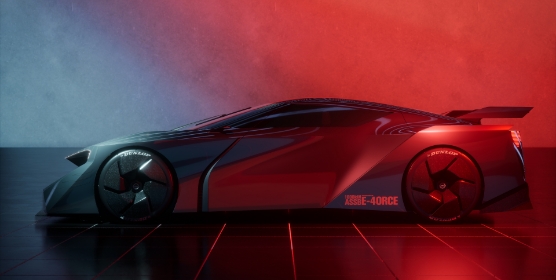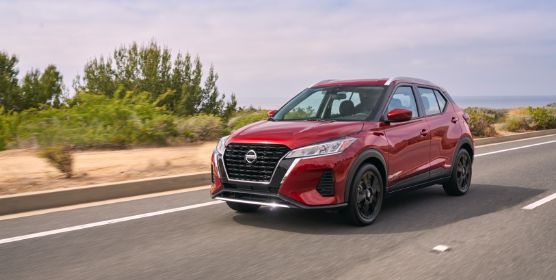Kunio Nakaguro, Executive Officer and Executive Vice President
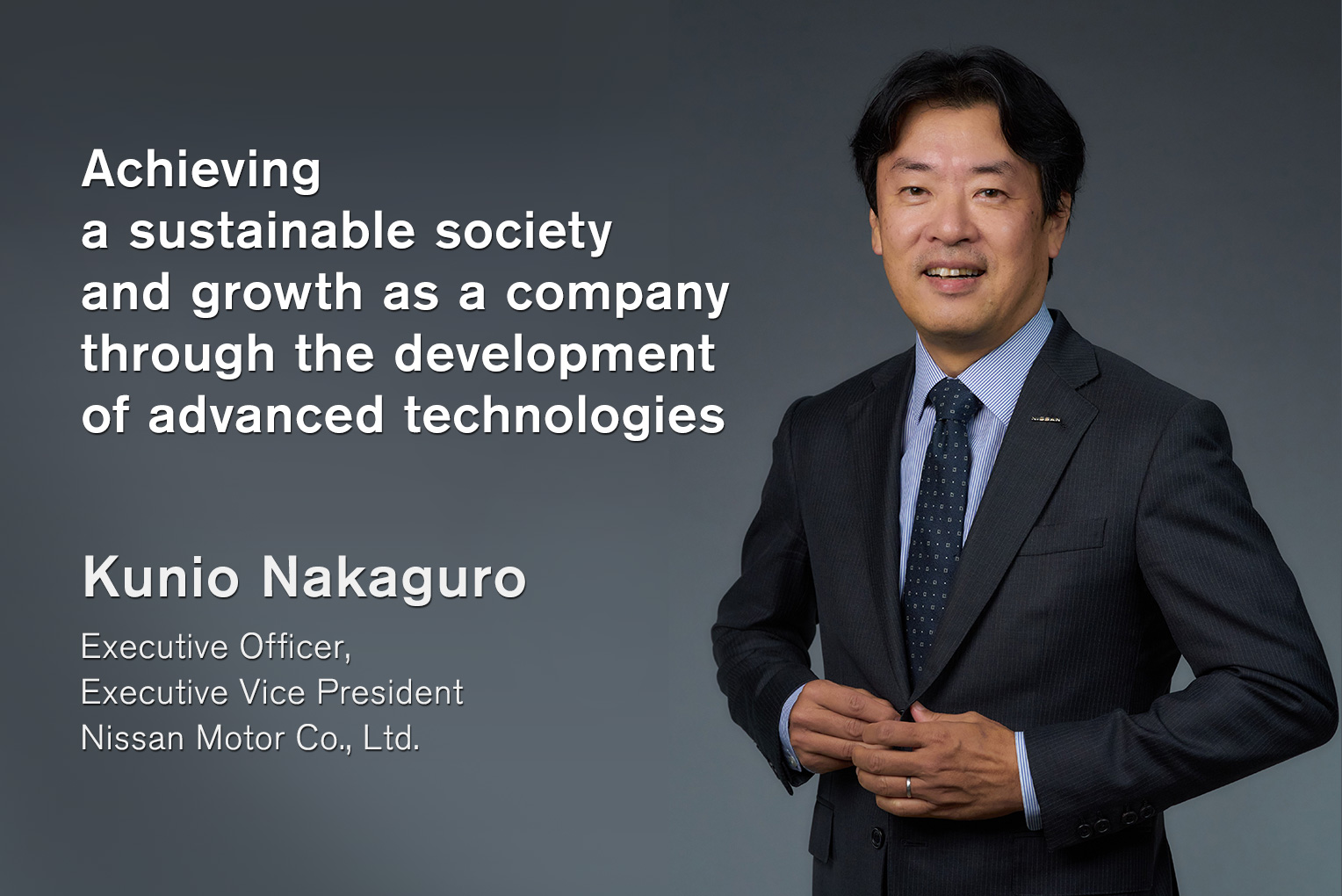
Nissan’s
competitiveness
has
always
originated
with
advanced
technologies.
Since
foundation,
Nissan
has
consistently
developed
and
commercialized
new
technologies
and
was
among
the
first
to
introduce
advanced
technologies
to
the
market.
Over
the
past
two
decades,
the
company’s
research
and
development
activities
have
been
based
on
two
pillars
of
advanced
technology
-
electrification
and
vehicle
intelligence.
We
believe
that
electrification
and
vehicle
intelligence
are
essential
to
solving
societal
issues
including
resource
depletion,
environmental
problems,
traffic
accidents,
and
traffic
congestion.
We
always
keep
in
mind
that
advanced
technologies
gain
value
after
they
become
available
to
our
customers
and
featured
in
our
vehicles.
Our
efforts
in
R&D
have
led
to
the
commercialization
of
electric
vehicles
(EVs)
and
e-POWER
for
electrification,
and
a
wide
range
of
advanced
safety
technologies,
such
as
ProPILOT
and
connected
technologies
for
vehicle
intelligence.
These
advanced
technologies
have
been
adopted
in
different
segments
and
are
widely
used
by
customers.
However,
the
decade
leading
up
to
2030
represents
an
age
of
uncertainty
in
which
the
social
environment
and
technologies
are
changing
significantly.
We
are
working
on
new
initiatives
to
address
these
anticipated
changes.
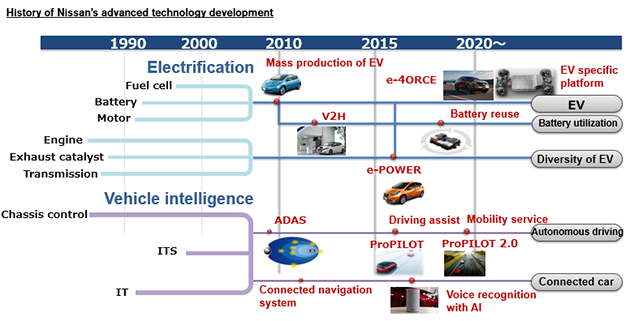
Contributing to the realization of a Zero Emission society through electrification
Since
around
1990,
Nissan
pioneered
the
research
and
development
of
batteries
and
motors
for
EVs
and
launched
the
mass-produced
EV,
Nissan
LEAF,
in
2010.
In
addition
to
vehicles,
a
number
of
technologies
have
been
introduced
with
the
objective
of
making
EVs
user-friendly
by
considering
the
use
environment
and
the
eco-cycle.
As
examples,
charging
infrastructure
standards
have
been
established.
Infrastructure
and
a
vehicle-to-home
system
have
been
developed.
A
battery
reuse
business,
4R
Energy,
was
established.
Real-world
accomplishments
and
accumulated
data
from
vehicles
and
customers
are
a
competitive
advantage
of
Nissan
to
promote
electrification.
Nissan
has
two
main
goals
in
expanding
electrification.
One
is
to
realize
our
vision
to
achieve
a
zero-emission
society.
The
other
goal
is
to
provide
customers
with
secure,
safe
and
comfortable
mobility
by
optimizing
the
significant
potential
of
motor
drive.
Due
to
its
excellent
controllability,
motor
drive
technology
enables
ideal
acceleration,
deceleration,
ride
comfort
and
cabin
quietness
for
the
driver.
In
addition,
motor
drives
are
highly
compatible
with
advanced
safety
technologies,
such
as
ADAS
(Advanced
Driver-Assistance
Systems)
and
autonomous
driving
technologies.
We
will
continue
to
enhance
the
attractiveness
unique
to
the
motor
drive.
In
addition
to
EVs,
Nissan
will
continue
to
offer
motor
drives
to
customers
worldwide,
including
regions
where
the
charging
infrastructure
may
have
not
yet
been
fully
developed,
by
supplying
motor-driven
e-POWER
models,
which
do
not
require
external
charging
of
the
battery.

Under “Nissan NEXT” business transformation plan, Nissan plans to sell more than 1 million electrified vehicles by the end of FY2023, increase the EV lineup with more than 8 models, and expand e-POWER availability across the regions.

1.EV
Nissan
prioritizes
safety
in
the
development
and
offering
of
its
EVs.
Especially,
as
per
battery,
prior
to
vehicle
launches,
extensive
tests
are
conducted
under
tough
conditions
in
order
to
ensure
safety
and
reliability,
while
increasing
the
battery
energy
density
for
higher
performance.
This
emphasis
on
safety
is
demonstrated
by
the
510,000
units*1
of
LEAF
sold
given
there
have
been
no
cases
of
serious
battery-related
accidents.
Through
driving
data,
we
forecast
severe
vehicle
use
scenarios
and
these
factors
are
considered
for
reliability
design,
test
standards
and
development.
We
also
continue
to
enhance
the
attractiveness
of
EVs
through
technology
development.
One
example
is
vibration-damping
control
technology,
which
resulted
from
the
development
of
the
LEAF
motor.
The
responsive
electric
powertrain
has
a
higher
potential
in
terms
of
controllability
than
an
internal
combustion
engine,
but
there
are
challenges.
For
example,
when
there
is
a
sudden
increase
in
torque,
occupants
may
feel
vibrations.
Vibration-damping
control
technology
tempers
these
vibrations
and
ensures
smooth
acceleration.
This
technology
and
the
knowledge
gained
from
all-wheel
drive
and
chassis
control
over
the
years
have
resulted
in
the
integrated
vehicle
control
technology,
e-4ORCE.
e-4ORCE
will
be
featured
in
the
all-new
Nissan
Ariya,
which
was
unveiled
last
year.
The
front
and
rear
motors
are
controlled
during
braking
and
driving
and
combined
with
chassis
control
in
order
to
provide
a
stable
and
comfortable
ride.
This
also
prevents
occupants
from
noticing
vibrations
or
fluctuations.
Such
technologies
allow
everyone
to
drive
with
confidence
and
comfort.
For
the
expansion
of
electrification,
it
is
necessary
to
reduce
the
cost
of
electric
powertrains
and
address
the
challenge
of
innovation
in
battery
technology.
Specifically,
the
development
of
cobalt-free
batteries
with
suppliers
will
be
accelerated
in
order
to
reduce
the
use
of
expensive
cobalt.
For
the
battery
pack,
a
Cell-to-Pack
structure
is
also
being
developed
in
cooperation
with
suppliers.
Under
this
structure,
the
cells
are
installed
directly
in
the
pack
without
modules
and
the
manufacturing
process
is
streamlined.
Through
these
technical
innovations,
we
believe
that
profitability
for
these
vehicles
will
be
equivalent
to
that
of
internal
combustion
engine
vehicles
before
2030.
All-solid-state
batteries
will
significantly
improve
safety
and
cost
competitiveness
and
are
also
being
developed
in
cooperation
with
organizations
such
as
the
Tokyo
Institute
of
Technology.
The
major
challenges
associated
with
this
development
are
the
enlargement
of
batteries
for
vehicles
and
the
production
process.
We
are
expediting
material
selection
and
technology
development
for
the
manufacturing
process
in
order
to
move
forward
and
achieve
mass
production
as
early
as
possible.

As a result of the rapid expansion of EVs, the used battery market is expected to grow in the future. Therefore, it is essential to implement measures for their appropriate use. Nissan established 4R Energy in Namie-machi in Fukushima prefecture. This company is developing technologies for reuse of batteries. 4R Energy’s business model entails sorting used batteries collected from the market and, based on their condition and performance capability, supplying them to various secondary users. This ensures that the value of used batteries will be returned to customers. This business will be expanded in order to reduce the cost burden on EV owners with the aim of further proliferation of EVs.
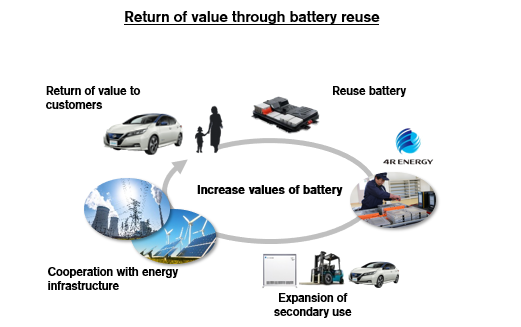
2.e-POWER
e-POWER,
which
utilizes
the
same
core
technology
as
EVs,
features
quiet
and
smooth
EV-like
driving
while
using
a
100%
motor
drive
with
maximum
torque.
The
all-new
Note
e-POWER
was
launched
at
the
end
of
2020
in
Japan
and
features
a
new
electric
powertrain,
which
integrates
an
inverter
and
a
motor
to
give
the
driver
improved
efficiency,
acceleration,
and
cabin
quietness.
In
addition,
a
new
system
is
under
development
for
the
premium
segment,
which
will
utilize
the
characteristics
of
e-POWER
and
improve
cabin
quietness
by
dampening
vibrations
transmitted
from
the
engine
used
for
power
generation.
A
challenge
for
the
expansion
of
e-POWER
is
the
cost
of
the
powertrain.
In
addition
to
developing
the
battery
technology
as
in
the
case
of
EVs,
we
are
working
to
simplify
the
system,
in
which
the
engine
is
dedicated
to
power
generation
and
operation
under
limited
conditions
in
order
to
achieve
cost
parity
with
internal
combustion
engines
by
2025.

Realizing zero fatalities for Nissan vehicles through intelligent vehicle technologies
Nissan’s
goal
is
to
reduce
the
number
of
deaths
resulting
from
accidents
involving
Nissan
vehicles
to
zero.
In
order
to
achieve
this
goal,
we
have
been
working
on
development
of
driving
assistance
technologies
to
respond
to
all
kinds
of
risks
related
to
traffic
accidents.
Nissan
has
led
the
industry
by
launching
various
world-first
safety
technologies
for
360
degrees
protection,
including
Lane-Keeping
Assist,
Around-View
Monitor
and
Emergency
Assist
for
Pedal
Misapplication.
Similar
to
the
case
of
electrification
technologies,
the
competitiveness
of
Nissan
originates
from
such
accomplishments
and
the
high
reliability
of
systems.
Furthermore,
we
aim
to
provide
all
customers
with
secure,
safe,
stress-free
and
comfortable
driving
through
these
driving
assistance
technologies.
ProPILOT,
which
was
launched
in
2016,
evolved
into
ProPILOT
2.0
in
2019.
This
system
offers
the
world’s
first
driver
assistance
system
to
combine
navigated
highway
driving
with
hands-off
single-lane
driving
capabilities.
Nissan
is
targeting
sales
of
more
than
1.5
million
vehicles
equipped
with
autonomous
driver-assistance
technologies
by
2023.
For
a
fully
autonomous
driving
future,
it
is
essential
to
increase
the
level
of
autonomy
and
provide
systems
that
everyone
can
use
with
confidence.
As
a
part
of
this
development,
Nissan
has
been
conducting
field
tests
on
Easy
Ride*2
with
driverless
cars
in
Yokohama’s
Minato
Mirai
area.
Through
these
test
drives
with
customers,
we
are
able
to
identify
potential
issues
associated
with
practical
use
and
continue
development
for
future
commercialization.
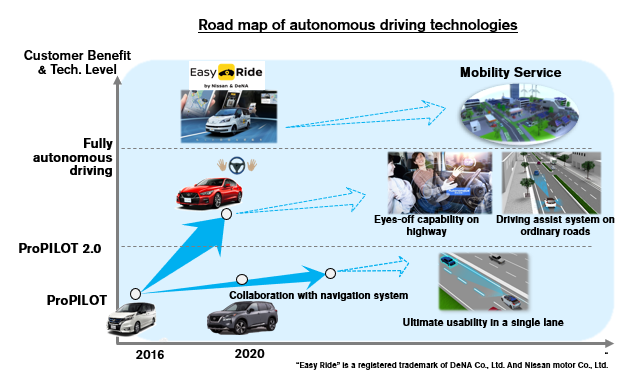
Under
real
world
driving
conditions,
fully
autonomous
driving
must
ensure
safety
in
the
event
of
obstacles
on
the
road.
Extensive
efforts
are
required
to
produce
object
recognition
technologies
that
will
account
for
a
wide
range
of
customer
driving
scenarios
and
road
conditions.
Therefore,
vehicle
control
technologies
as
well
as
the
research
and
development
of
base
components,
such
as
sensors
and
cameras,
will
be
prioritized.
Commercializing
these
technologies
in
the
global
market
requires
a
deeper
understanding
of
the
market
environment,
and
road
conditions
have
been
modeled
for
this
purpose.
We
will
enhance
development
efficiency
by
reproducing
different
driving
scenarios
worldwide
based
on
market
data
and
high-definition
map
data
obtained
through
the
development
of
ProPILOT.
Nissan
uses
a
driving
simulator
that
reproduces
market
conditions
and
actual
vehicle
patterns
in
its
development
of
autonomous
driving
technologies.
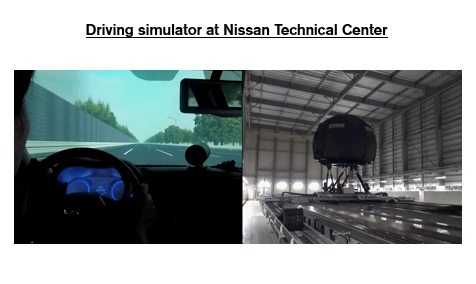
Global advancement of Alliance connected technologies
For
many
years,
Nissan
has
produced
technical
innovations
in
connected
technologies
that
offer
various
services
to
vehicle
occupants
through
cloud
services.
In
1998,
“Com-Pass
Link”
was
developed,
which
combined
vehicles
with
information
technology
through
the
car
navigation
system
and
mobile
phones.
This
was
also
Japan’s
first
operator
service.
In
the
future,
additional
services
will
be
provided
through
faster
communication
between
the
vehicles
and
cloud
services/servers.
For
example,
several
services
are
in
development.
Remote
control
and
automatic
settings
for
various
functions
through
the
use
of
smartphone
applications
will
allow
the
driver
to
easily
perform
a
series
of
actions
before
entering
the
vehicle.
Driver
intentions
based
on
driver
preferences
and
behaviors
will
be
analyzed
using
big
data
to
incorporate
results
with
an
advanced
interface,
so
that
the
driver
can
intuitively
perform
different
functions
while
driving.
These
functions
are
supported
by
Alliance
cloud
services
and
on-board
platforms.
They
will
be
deployed
and
promoted
globally
alongside
carriers
and
service
providers
around
the
world.
The
architecture
of
the
system
software
and
hardware
has
become
increasingly
complex.
To
address
this
issue,
innovations
for
efficiency
are
under
development
by
streamlining
the
system
through
module
design
and
adopting
automatic
function
evaluation
methods
using
digital
analysis
tools.
Enhancement of future mobility business
The
advanced
technologies
discussed
above
help
enrich
society
in
addition
to
serving
Nissan
customers.
For
example,
EVs,
also
known
as
energy-stored
cars,
play
an
active
role
in
supplying
power
during
disasters.
Through
the
“Blue
Switch”
project
in
Japan,
Nissan
contributes
to
society
through
arrangements
with
many
local
municipalities.
The
vehicle-to-grid
system
is
also
being
studied
to
help
control
power
supply
and
demand.
This
system
connects
reused
battery-based
energy
storage
with
existing
power
grids.
Furthermore,
for
the
mobility-disadvantaged
in
rural
areas,
the
company
is
collaborating
with
local
municipalities
and
working
toward
an
environment
where
everyone
can
move
with
confidence
and
safety
by
using
various
technologies
including
advanced
safety,
autonomous
driving,
electrification
and
connectivity.
Simultaneously,
through
these
activities,
we
are
looking
to
establish
appropriate
business
models.
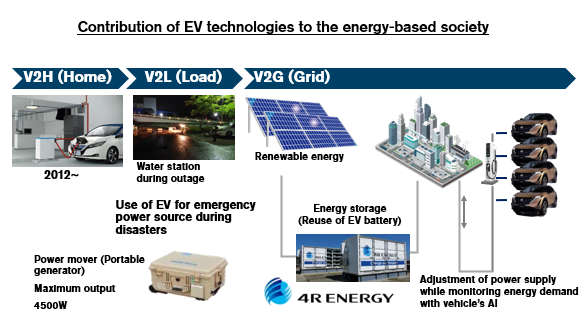
In
addition
to
electrification
and
vehicle
intelligence,
Nissan
is
working
on
research
and
development
of
various
advanced
technologies
such
as
vehicle
weight
reduction
by
using
different
types
of
materials
and
optimizing
interior
conditions
based
on
the
physical
condition
of
occupants
obtained
through
bio
signal
recognition.
Nissan
aims
to
enrich
the
daily
lives
of
its
customers
worldwide
by
expanding
the
appeal
and
joy
of
its
unique
advanced
technologies.
We
are
confident
that
this
vision
will
shape
the
future
mobility
of
society.
At
the
Research
and
Development
Division,
we
will
work
together
and
continue
to
embody
the
“Technology
of
Nissan.”
- As of the end of January, 2021
- “Easy Ride” is registered trademark of DeNA Co., Ltd. and Nissan Motor Co., Ltd.
Published in August 2021



